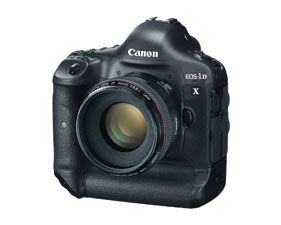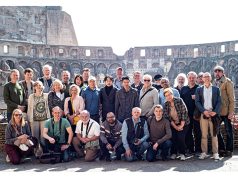
Lake Success, NY—Canon introduced a completely redesigned EOS-1D series digital SLR—the Canon EOS-1D X—calling it the “high-speed multimedia juggernaut” that replaces both the EOS-1Ds Mark III and EOS-1D Mark IV models in Canon’s EOS lineup.
Enhancing the image quality of the EOS-1Ds and speed capabilities of the EOS-1D series, the 1D X features an 18 megapixel full-frame Canon CMOS sensor, dual Digic 5+ imaging processors, 14-bit A/D data conversion and 12 frames-per-second (fps) shooting.
The announcement comes on the heels of Canon’s recent manufacturing milestone with the production of its 50-millionth EOS SLR camera in September 2011. Furthermore, Canon will achieve another milestone at the end of this month, producing the 70-millionth EF lens.
“The EOS-1D X represents the reinvention of the EOS-1Ds and EOS-1D series, combining new proprietary Canon technologies with the culmination of customer feedback and requests from the field. We are proud to introduce this camera to the worldwide community of professional photographers and cinematographers with the features and capabilities they need to capture the great moments that display their talent,” said Yuichi Ishizuka, executive vice president, general manager, Imaging Technologies and Communications, Canon USA.
The EOS-1D X uses three Digic processors, including dual Digic 5+ image processors engineered to deliver 17 times more processing speed than Digic 4, and a dedicated Digic 4 for metering and AF control. Working with the newly developed 18MP full-frame Canon CMOS sensor, the dual Digic 5+ processors provide high-speed continuous shooting, lower noise and a significant increase in data processing speed than previous EOS-1D models. This allows the EOS-1D X to perform functions like chromatic aberration correction for various Canon EF lenses in-camera instead of through postproduction software. The Digic 4 processor utilizes a new 100,000-pixel RGB metering sensor for enhanced exposure accuracy with color and face detection, and it works with the camera’s new EOS iTR (Intelligent Tracking and Recognition) AF, ideal for wedding and event photography as well as sports and photojournalism. The default AF mode for the EOS-1D X uses phase-detection AF information, while a new second option uses Face Detection technology to track recognized faces in addition to color information.
The expanded low-light capability of the EOS-1D X enables it to photograph in extremely low-light conditions; adjustable from ISO 100 to 51,200 within its standard range, the camera offers a low ISO 50 setting for studio and landscape photography and two high settings of 102,400 at H1 and 204,800 at H2.
Also new is its 61-point high-density reticular AF system with 21 cross-type focusing points in the central area. All 61 points are sensitive to horizontal contrast with maximum apertures as small as f/5.6, and 20 of the outer focusing points function as cross-type points with maximum apertures as small as f/4.0. All AF functions have their own menu tab for quick access, and an AF configuration tool allows for customized setting of tracking sensitivity, the acceleration and deceleration of tracking subjects, and AF point auto switching. A built-in feature guide advises photographers on which settings to use according to subject matter.
Similar to the AF point selection options in the EOS 7D, the EOS-1D X has six AF point selection modes: spot; single point; single point with surrounding four points; single point with surrounding eight points; zone selection; and automatic AF point selection.
Other features include: 252 zones for general metering, 35 zones for low-light metering; new subject recognition capabilities that enhance nearly all of the automatic functions, helping to adjust exposure, autofocus, auto lighting optimizer and automatic picture style; multiple exposure capability that combine up to nine images into a single composite image in-camera, with results shown in real time on the LCD; a super high-speed mode that increases shooting speeds to 14 fps at full 18MP in JPEG mode; RAW, JPEG, or RAW+JPEG shooting at 12 fps in one-shot AF or AI servo AF; dual CF card slots; 400,000-cycle-rated shutter blades; and a built-in LAN connection offering a stable wired connection for image transfer.
The EOS-1D X utilizes new HD video formats to simplify and speed up postproduction work. Two new compression formats include intraframe (ALL-i ) compression for an editing-friendly format and interframe (IPB) compression for superior data compression. And answering the requests of cinematographers, the EOS-1D X includes SMPTE-compliant time-code embedding methods, rec run and free run, allowing multiple cameras or separate sound recording to be synced together in postproduction.
The camera records in Full HD 1,920×1,080 with selectable frame rates of 24p, 25p, or 30p; and 720p HD or SD video at 50p or 60p. Canon’s new full-frame CMOS sensor also helps ensure that video footage will exhibit less moiré than previous Canon model. And a desired feature for many documentary filmmakers using Canon DSLRs was to enable recording beyond the four gigabyte file capacity, so the EOS-1D X features automatic splitting of movie files when a single file exceeds 4GB. The file splitting function allows for continuous video recording up to 29 minutes and 59 seconds across multiple 4GB files; no frames are dropped, and the multiple files can be connected in postproduction, providing filmmakers the recording time they want in the same convenient DSLR form factor.
The EOS-1D X also includes manual audio level control, adjustable before and during movie recording, and a wind filter. Sound can be recorded through the internal monaural microphone or via an optional external microphone through the stereo mic input.
The control configuration of the weather-resistant EOS-1D X takes a different approach to button placement than 1D-series cameras. The exterior and ergonomic button configuration was redesigned to allow easier navigation through menu options. The live view button is now placed near the user’s thumb for one-touch switching between live view and the viewfinder, and the quick control button and menu navigation controls let users change settings using only their right hand on the scroll wheel. A new multi-controller is positioned by the right thumb for when the camera is held for vertical shooting. And on the front are four user-assignable function buttons, two for vertical shooting and two for horizontal shooting.
Canon’s EOS-1D X DSLR is scheduled for March 2012 and will be sold in a body-only configuration for $6,800. New optional accessories include the compact WFT-E6A wireless file transmitter, scheduled for March 2012 with an MSRP of $600; and the GP-E1 GPS receiver, expected in April 2012 with a price of $300. usa.canon.com





